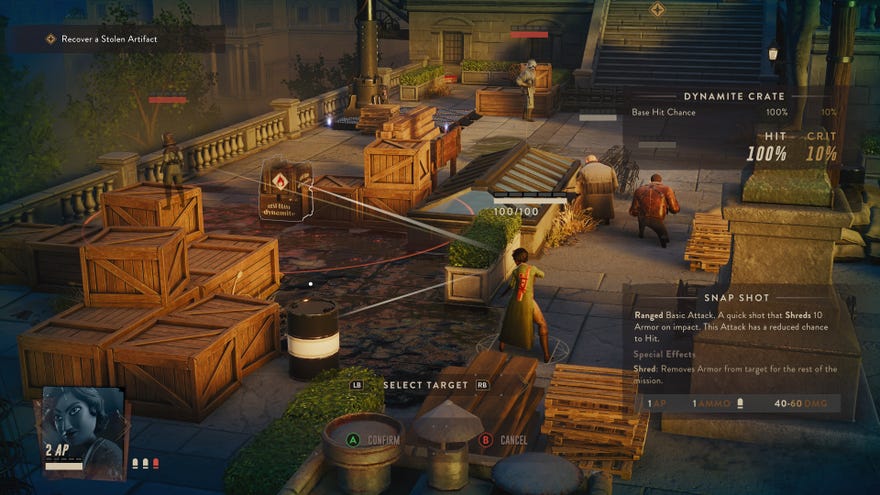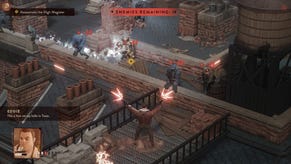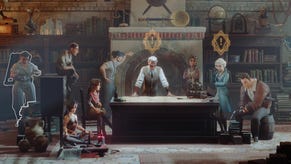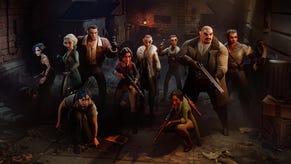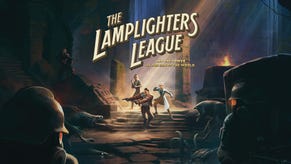The Lamplighters League pilfers from the finest strategy games around, and it's utterly thrilling
Relight my fire
As is so often the case in systemic turn-based tactics games, things started to go wrong in my preview session for The Lamplighters League when a nearby torch met a cunningly placed oil slick and erupted into flames. A load of enemies were instantly enveloped in its hot sea of death, as intended, but one of our heroes - the tank-like bruiser Fedir - also ended up getting burned by mistake. As an ex-mob enforcer, he's certainly built to take a few punches, and his abilities are all focused on making him the centre of attention, his attacks growing more powerful as his rage levels continue to grow. "You want him to get attacked," game director Chris Rogers tells me, calling on the phrase 'you wouldn't like him when he's angry' as the basis for Fedir's ability set. But with that extra fire damage he receives, it's just a little too much all at once. He gets knocked down, and the tide of battle quickly goes south.
In truth, I played no part in this downfall. Rogers was in the control cockpit for this one, showing me exactly how Harebrained Schemes' latest game actually works. It's quite a different proposition from their last game, Battletech, and in this quite literal trial by fire, studio head and co-founder Mitch Gitelman actually pulled a dollar out of his pocket at one point and put a bet on whether Rogers would make it out alive. He certainly had his work cut out for him. Rogers won that dollar, and here's how the game's emphasis on deep, customisable character builds set him up for success.
The Lamplighters League starts in your team's hideout, a hub screen where your ten agents hang out between missions. You'll only have three to start with, mind, which you can pick from individually or let the game's randomiser choose for you. The rest you'll need to find and recruit out on the map, which is currently being controlled by three evil factions in this alternate 1930s cold war: the Castro, the Marteau and the Strum. Each has their own goal - Castro's trying to raise an eldritch god, Marteau is obsessed with exploiting weird science for profit, while the Strum are totalitarian raiders looking for lost artefacts to bring the whole world to heel - and a dial meter to go with it. When these dials reach 100%, the world is lost and it's game over - although not without giving players a last ditch mission attempt to try and foil the enemy's plans and bring them back under control.
These Lamplighters aren't your ordinary batch of heroes, however. As publisher Paradox Interactive revealed earlier this month, you're working with "the best of the worst" in this grid-based strategy game, as the best of the best were all biffed to high heaven in World War I. As such, you're bringing together a band of thieves and bandits, balancing the need to recruit new people to your team, find allies to help you get more resources to go on off-screen search expeditions, and stealing each faction's precious treasures in a series of well-planned (or chaotic) heists in order to sabotage their world domination plans.
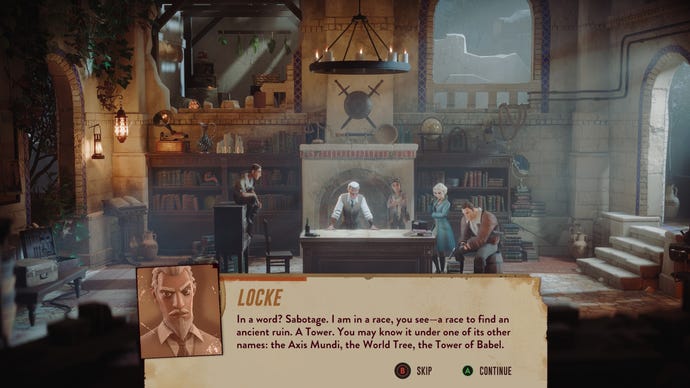
In my preview session, we had the aforementioned Fedir, warrior nun healer Anna Sophia, and cult assassin Celestine who, rather like Hard West 2's Flynn, uses dark magic for the greater good, albeit at a cost to herself. Naturally, each character has their own abilities and individual skill trees to dig into, but you'll be able to give them special bits of gear and consumable items to help them in battle. So far, so XCOM-like. But the real kicker comes in the form of 40 tarot cards that can be used to give your heroes unique abilities and passives, allowing you to "put together your way of playing," says Rogers.
"This plays a little bit looser than [Shadow Tactics and Desperados 3]. Our stealth gameplay is more like the opening gambit."
Missions being in real-time, giving you space to roam the procedurally generated map (as long as you remain undetected, that is), get a lay of the land and plan your combat attacks. It calls to mind Mimimi's stealth strategy games Desperados 3 and Shadow Tactics: Blades Of The Shogun, but Rogers tells me "this plays a little bit looser than that" and that it won't be "quite as punishing" (although try telling that to Fedir). "You'll make mistakes, kind of recover and play through the tactical stuff," he says. "Our stealth gameplay is more like the opening gambit."
To demonstrate, Rogers picks off a few goons guarding a nearby radio tower with each character's special real-time ability. Fedir has a powerful charge attack, while Anna can throw lures to distract guards to look in a certain direction. Celestine, on the other hand, is better at sneaking, cutting the awareness circle around an enemy's feet in half, allowing her to creep up from behind without being noticed. These all have limited charges, Rogers tells me, so don't expect to be able to take out the entire map without getting into a fight.
"A lot of the world is procedurally-generated," says Gitelman, "so we're not exactly sure what's about to happen. Sometimes different enemies will appear, different enemy group sizes, different cover, different pick-ups, things like that."

The size and type of an enemy group is only one part of the puzzle, though. Each enemy also has their own individual armour and stress levels, which you'll need to break both of to do mega damage. Some of the guards onscreen have an armour of 18 or 20, so we already know they're going to be tough to takedown, but stress is only accumulated when they're attacked - and when they reach maximum stress, they're effectively staggered for a turn so you can really lay into them. You'll need to be careful, though, as the same rules apply to you, so you'll need to keep your weaker characters out of harm's way behind a plentiful supply of full and half-height cover.
If one of your party does get stress broken, however, then they'll pick up a card that has a negative effect. "The idea is that that last mission was too much for them and they picked up this kind of traumatic effect," says Rogers. "A character might become reckless and they'll not be able to hit anything unless they're out of cover. Or they might become cowards. They all have gameplay effects, and they're pretty bad. You can choose to fight with them, like they're working through it, and you'll get a reward. Or you can rest them for a little bit and the card will go away."

The creation of Lamplighters' ten agents was a close collaboration between Harebrained Schemes' designers and narrative teams. They started with some basic tropes - "We need a big sort of bruiser guy, right?" - which the narrative team then fleshed out with back stories - "What if he was a Russian mob enforcer who's covered in scars?" Those concepts then go to the designers, who build on them further - "What if, when he gets enraged, he can deal more damage and stuff like that." It's the "little details," Rogers says, that allow the design team to turn them into mechanics, "and that's cool as hell. It's one of the reasons why creating our own IP allows for that." Image credit: Paradox Interactive
At first, these break cards make me think of the scars you can gain in XCOM: Chimera Squad, which lets you turn negative effects gained in battle into more positive traits for your veteran soldiers through additional training. But it sounds like there's going to be a bit more risk-reward at play in Lamplighters, with players having more agency over how they decide to proceed. "If a character can't take good shots because there's a big penalty to shoot from cover, it's up to you. Do you want to go out there and stand in the open and take good shots? Or do you just have to carry that character through to the next mission?"
None of Rogers' characters have such a debilitating effect in this mission, but he chooses to keep all three out in the open for a surprisingly long time, using long-range attacks to gradually chip away at enemy health bars as they descend from all angles. The first order of the day is for Celestine to possess a super strong mummy monster, turning one of the most powerful enemies on the board to our advantage. There are two percentages you'll need to be aware of when firing off attacks - the first is your chance to hit, and the second, golden figure is your chance to crit, Rogers tells me, the latter of which is resolutely stuck at zero for most of the encounter's opening salvo.
But Celestine is a character whose entire deal is to pile on stress, and with Fedir drawing all punches and bullets into his brawny chest, she's then free to deal out her debuffs from behind. Anna Sophia's SMG, meanwhile, lets her attack twice in the same action point - a blessing when normally each character only gets two per turn. And even when she misses, the enemy's stress meter still creeps a little bit higher.
But if you stick to The Lamplighters League's default pair of action points, you're missing out on half the fun. Much like Marvel's Midnight Suns, Gears Tactics and other recent strategy greats, what you're really driving at in Lamplighters is what Gitelman calls "the big turn". That is, stretching your well of action points as far as they'll go in order to maximise the number of attacks you can perform each and every turn.
Anna Sophia, for example, currently has a rare relic equipped that gives her another AP every time she heals somebody. Combine that with her once-per-mission signature ability for a massive AOE heal, and you'll be positively rolling in the stuff if you get everyone within range. Rogers says this relic is something players will have to "work really hard for" in the final game, but in this instance, it's just the ticket he needs to let him perform another heal on our friend Fedir, who's been knocked down after taking too much damage in the unexpected fire breakout. Fedir himself also has attacks with various secondary effects that kick in when he's properly enraged, such as allowing him to heal for the amount of damage he puts out. But here Rogers has also given him a special tarot card that lets him heal even further.
Together, Rogers manages to get himself out of a pretty tight spot, but the fun's not over yet. This particular map has also spawned a reinforcements tower, which is about to send in another wave of enemies to the fray. Luckily, Anna's signature heal has also recharged Fedir's throw, allowing him to knock down a bunch of stragglers for another turn to help keep them at bay. This opens up a stress break for one of them, and Rogers' eyes light up.
"Okay, this is really great because Celestine, she - " He stops, realising he's one AP short of being in range to execute his plan. "What would have been really cool about this," he laughs, "is that Celestine's signature [Coup De Grace], because she feeds on stress, we could have recharged her signature if we could get to that guy and keep the big turn going. As it is," he sighs, "sometimes I think you don’t want to overthink it too much and you just want to start shooting."


He lets rips with Anna's SMG, but the numbers just aren't in his favour. Anna goes down properly this time - not just a knockout - and needs to be revived in order to get back in the fray. Rogers says characters can be downed and picked back up twice per mission, but if they get mullered a third time, they'll be captured by the enemy and you'll lose them back to the map. On the game's default difficulty, you'll be able to find them again and break them back out of their temporary prisons, but if you're playing on Ironman, "that's it," he says, conjuring terrible flashbacks of XCOM and Fire Emblem's permadeath.
It's not looking good for Anna right now, though, as one of the reinforcements that have just arrived is a magister, who can summon even more enemies if they're not dealt with quickly. "We're doing great. This is going to be fine," Rogers says frantically. Gitelman suggests possessing the magister, but once again Rogers is too far away right now. "If I wait a turn, I'm not sure I'm going to get another one!" he despairs.
Alas, before Rogers can plan his next move, my own curse of another upcoming GDC appointment kicks in and I have to leave before I can see the mission through. Rogers still has eight enemies to take down when I depart, and I get them to promise to tell me how it pans out. Incredibly, most missions have two of these big encounters, according to Rogers, and I'm left wondering how on earth he'll get through the next one unscathed, if indeed he manages to emerge victorious from this first one. Admittedly, this particular mission is from "deep" within the game, hence its difficulty, but there's a potential third battle on the cards here as well thanks to a free-roaming boss character. These are known as Scions, and you'll encounter them multiple times throughout the game. To begin with, you'll most likely want to run away from them given their superior strength, but if you manage to defeat them, they'll be removed from play for a while. "When they come back, they'll be stronger," says Rogers. "And they'll remember you," adds Gitelman, revealing a light, Nemesis System-style twist to make fights feel more dramatic on the second go.
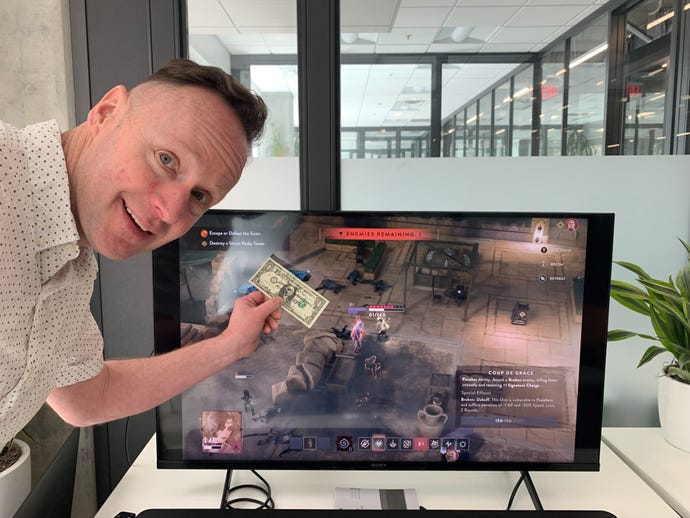
For now, though, I leave Rogers and Gitelman to duel over their one dollar bet. I wished I could have stayed to see what happened next, if only because when I open my emails the next morning, I have a message from them with a photo (see right) of Rogers standing proudly in front of the TV with his no-doubt hard-won dollar, signed and dated by Gitelman. There is now only one enemy remaining onscreen, with Celestine finally poised to instant-kill them with her Coup de Grace finisher ability. It also looks like another fire broke out at some point, leaving the cobblestones charred and black around the arena. I have no idea how he did it, but man alive, I sure can't wait to try it all for myself when The Lamplighters League comes to Steam and the Epic Games Store "soon".
